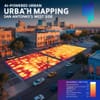San Antonio’s West Side has become a focal point for researchers tackling the city’s urban heat island (UHI) problem. A collaboration between the Southwest Research Institute (SwRI) and the University of Texas at San Antonio (UTSA) launched a joint study in 2023 to measure “felt heat” – the temperature people actually experience – using a network of sensors that capture air flow, wind speed, humidity, and surface temperatures. The work is supported by a $125,000 grant from the Connect program and aims to create an energy‑balance model that reflects real‑world thermal comfort, not just satellite data .
The project uncovered striking temperature extremes: measurements recorded up to 154 °F just above pavement, highlighting how heavily paved areas radiate heat far beyond the ambient air temperature. Researchers stress that satellite imagery alone misses the micro‑climates under trees or in shaded spots, so the sensor network will provide a more granular picture of heat exposure across neighborhoods .
SwRI also built a comprehensive data‑fusion tool that merges over 230 datasets from city departments, public databases, and the new sensor network. This tool lets city planners run scenario analyses, overlaying hot spots with bus‑stop locations, vulnerable populations, and potential mitigation sites such as tree‑planting zones or reflective surfaces. Early case studies show that many high‑heat areas coincide with busy bus routes, suggesting targeted interventions could protect pedestrians and improve public‑transport use .
The combined efforts are feeding into San Antonio’s broader climate‑resilience agenda, including the Cool Neighborhood Program and the SA Climate Ready initiative. By quantifying felt heat and identifying priority zones, the city hopes to deploy green infrastructure, cool pavements, and community‑focused cooling centers more strategically. The AI‑driven insights promise not only to reduce surface temperatures but also to address socioeconomic disparities in heat exposure, ultimately making the West Side a cooler, healthier place to live .


